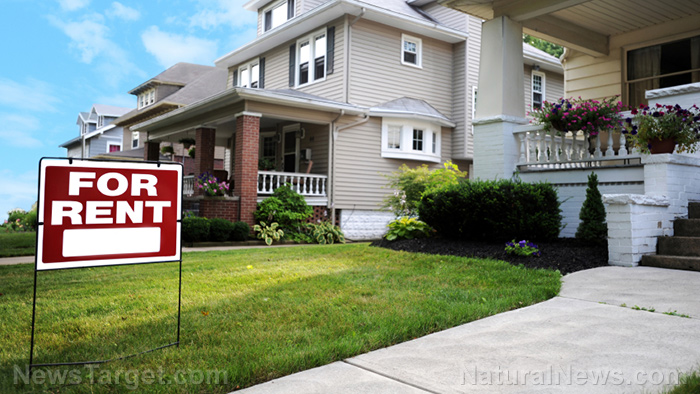Lumber prices fall as rising interest rates affect housing industry
06/01/2022 / By Mary Villareal

Another sign of how rising interest rates are deflating markets that boomed during the Wuhan coronavirus (COVID-19) pandemic can be seen in lumber prices, which have started crashing down.
Wood prices were a leading indicator of the supply chain problems and inflation following the pandemic lockdowns. Prices shot up in the summer of 2020 as a large number of Americans remodeled their homes and surged the demand for suburban housing.
By spring, lumber costs more than twice the pre-pandemic highs. However, two-by-four prices are now flashing caution as futures for July delivery ended May 27 at $695.10 per thousand board feet, down 52 percent from a high in early March.
On-the-spot wood prices also changed, with pricing service Random Lengths saying that its framing composite index, which tracks cash sales, fell around 12 percent at $794, down from $1,334 in March and just before the Federal Reserve raised interest rates for the first time since 2018.
The Fed raised its rates again this month and is expected to continue to lift borrowing costs to slow consumption and limit inflation, although the housing market is expected to shoulder the load. (Related: Inflation accelerates as companies stock up in anticipation of surge in demand.)
The central bank is also pursuing an interest rate that will slow the surge in home prices by trimming the number of buyers without triggering an economic slowdown.
Higher rates, expensive asking prices taking their toll on housing market
Higher rates and a limited supply of houses for sale, as well as their expensive asking prices, are beginning to take their toll.

Last week, the average rate on a 30-year fixed-rate mortgage was 5.1 percent, up from 3.1 percent at the beginning of the year, which further strained affordability.
Sales of newly built homes also fell by 16.6 percent in April from March to the lowest level since April 2020, when lockdowns affected markets. It was the biggest drop in nine years as well, the Department of Commerce said.
Single-family home completions, construction and building permits also dropped in April according to the Census Bureau. Meanwhile, Lumber buyers have slowed orders and had wood piling up at mills, which are also cutting prices.
“Triple-digit discounts became the rule rather than the exception,” Random Lengths said in its weekly price bulletin.
Others are also concerned about a big slowdown in construction, with many not stocking up like they were in the previous years when dealers and builders were having trouble meeting demand and hoarding lumber when they could find it.
A monthly survey from John Burns Real Estate Consulting showed that 12 percent of building-products dealers said they had slightly low to very tight inventories of lumber and wood panels in April, down from 61 percent that claimed low supplies the previous year. (Related: Get ready for the most painful inflation since the Jimmy Carter years of the 1970s.)
Prices are falling because demand for new homes has been dampened by higher mortgage rates, according to Matthew Saunders, who led the firm’s building-products research.
Barring a recession, Saunders still does not expect lumber prices to fall back to pre-pandemic levels, which rarely exceeded $500 per thousand board feet. This was partly due to problems in Canada’s western forests, where mills have struggled with fires, flooding, high-priced and hard-to-get timber, shipping problems and duties in the U.S. border.
The National Association of Home Builders also noted that extremely volatile lumber prices during the past year caused the increase of the average price of a new single-family home to increase by over $18,600.
Canfor Corp, one of the biggest lumber producers in the continent, said it was extending reduced operating schedules at its sawmills in Western Canada. It will also implement a two-week rotating downtime in the summer because of the lumber stacking up in the yards. Canfor also said its Canadian sawmills were operating at about 80 percent capacity since late March.
Lumber traders and analysts are also eyeing the aisles of Home Depot and Lowe’s, looking for signs that consumers are shifting spending away from home-improvement projects to entertainment vacations.
Meanwhile, Ikea will begin selling residential solar panels in the U.S. by fall in a move that it will carry out in partnership with residential technology provider SunPower, which will help customers design and install complete solar energy systems in their homes.
Follow SupplyChainWarning.com for more related stories.
Watch the video below to know more about the price of lumber and shipping amid the soaring inflation.
This video is from the Thrivetime Show channel on Brighteon.com.
More related stories:
New home sales drop to lowest level since pandemic began as engineered economic implosion spreads.
The end of the global economy as we know it.
Sources include:
Submit a correction >>
Tagged Under:
Bubble, chaos, Collapse, consumer goods, economy, Inflation, lumber, market crash, money supply, products, raw materials, risk, supply chain, supply shortages, wood prices
This article may contain statements that reflect the opinion of the author
RECENT NEWS & ARTICLES
COPYRIGHT © 2017 COLLAPSE.NEWS
All content posted on this site is protected under Free Speech. Collapse.news is not responsible for content written by contributing authors. The information on this site is provided for educational and entertainment purposes only. It is not intended as a substitute for professional advice of any kind. Collapse.news assumes no responsibility for the use or misuse of this material. All trademarks, registered trademarks and service marks mentioned on this site are the property of their respective owners.





















